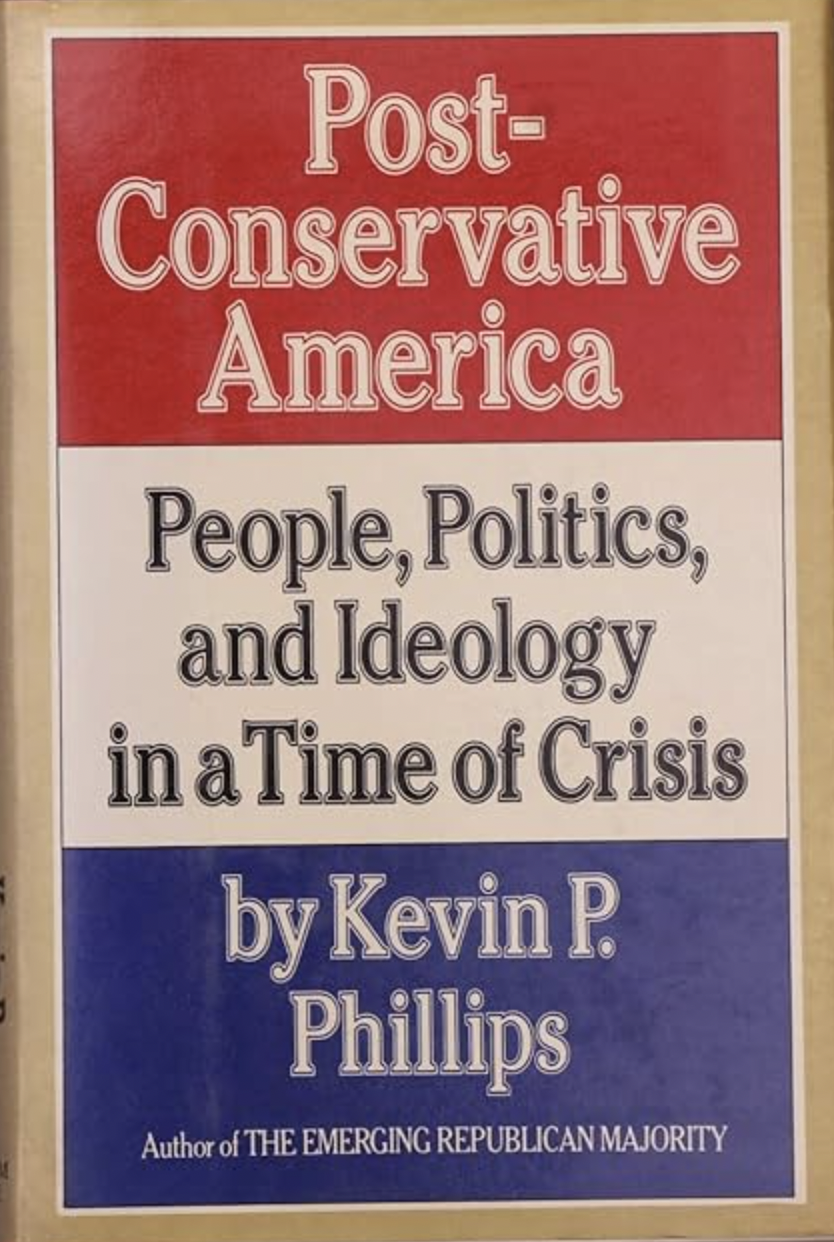The basic thesis of Mr. Kevin Phillips’s Post-Conservative America is by now familiar to most literate conservatives. American conservatism, Phillips argues, has failed to respond adequately to continuing, deeply fixed resentments and frustrations within mainstream American society. These frustrations are being aggravated and will continue to build during the 1980s as uncontrollable inflation, demographic changes, the obsolescence of the American constitutional and political systems, and a revolution in lifestyles and political values continue. The result will be the emergence of a right-wing radicalism that will bear little resemblance to “Old Right” conservatism of either traditionalist or libertarian orientations, to “neoconservatism,” or even to much of the current “New Right” movements. Phillips goes so far as to suggest that the United States in the 1980s will resemble the Weimar Republic of the 1930s, and that racial, ethnic, regional, and sectarian identities will play an overt and important role in our politics. The Reagan administration will not answer or satisfy these frustrations, since the president and his advisors have misunderstood the election of 1980 as a demand for Coolidge-era free market and pro-business Republicanism and not as a vocalization of new forces and values. Phillips therefore sees the post-Reagan American right as a potentially serious movement that will abandon many of the haute bourgeois and constitutionalist themes of conventional conservatism and espouse a more populist, radical, authoritarian, nationalist, and even racialist politics.
In general, I concur with Phillips’s predictions. Indeed there is a remarkable similarity between his analysis and that of an essay I contributed to Robert W. Whitaker’s collection, The New Right Papers, published earlier in 1982. Not surprisingly, the American left has denounced both Phillips and me for advocating “fascism.” To this charge I can say only what I (and Phillips) advocate is not fascism and what we predict may become fascism or something like it—against our wishes. Nevertheless, I disagree with, or at least question, some of the analysis by which Phillips reaches his conclusions, and I would argue that once his mode of analysis is corrected, his perception of a rising American fascism is considerably diminished.
As Phillips admits in his “Introduction,” in explaining his methods of analysis:
Ideas count, yes. But they are only one factor in a list that also includes population change, economics, ethnic and religious tribalisms and sheer voter frustration. . . . Concerned with elites, regional antagonisms and popular frustrations, my framework attaches somewhat less importance to forces like the conservative intellectual movement, neo-conservatism and supply-side economic theory than the other schemes might.
I have no serious quarrel with this emphasis on material and psychic rather than ideational causes, but Phillips’s real problem arises from his lack of any “framework,” any system by which he can assign priority to demography, economic trends, popular ideas, and mass psychology. Consequently, his analysis tends to exhibit an appearance of arbitrary selection of facts, theories, hypotheses, and historical analogies. He is probably correct, for example, that the West is undergoing a “price revolution” similar to that experienced by the sixteenth and early seventeenth centuries, but he has no way of showing how important this inflationary cycle is going to be for our political future, nor does he consider very deeply the many differences that distinguish the late twentieth century (and its response to inflation) from the early modern period. The result is a well-informed and indeed learned book with many imaginative insights and suggestions, but not very convincing to those who demand rigorous argumentation.
A key element in Phillips’s prediction of a coming reaction is his belief that the Watergate scandal and the loss of the Vietnam War can be resuscitated as issues for the right. Watergate can be portrayed as an effort by entrenched and somewhat sinister forces in bureaucracy and the media to derail a radical restructuring of government by President Richard M. Nixon. The Vietnam War can be portrayed as having been lost because of a “stab in the back” by the same powers. While I am decidedly inclined to believe the latter and am open to the former, I doubt that either issue will ever be overtly revived in the future. Mr. Nixon, whatever his vices and virtues, never generated the kind of mass loyalty to himself that would lead to political revanchism in his behalf. Neither did the Vietnam War. Unlike the loss of World War I for Germany, the loss of Vietnam did not result in a change in our form of government, the wreckage of our society and economy, and the widespread undermining of our values (they were already being undermined). Insofar as Phillips’s “Weimar analogy” depends on the revival of Watergate and Vietnam as energizing issues for the right, I cannot see that it is valid.
Phillips is undoubtedly correct in pointing to a latent dynamism in the Southern and Sunbelt regions that is thwarted by regulation and conventional (i.e., liberal) political norms. Yet, as he points out, the political future of these regions is uncertain, given the massive influx of Latin American immigrants and the prospect of their eventual politicization. One of the weakest parts of his thesis is its avoidance of the question of who will organize and provide the leadership for the new right-wing radicalism. Granted that the will, mass, and energy are there, who will discipline them and make them capable of exercising significant political power? Surely such a movement would require more than what most of the New Right now provides in the way of direct mail fundraising, hair-raising political advertisements, and week-long sermons on the sinfulness of big-spending bureaucrats and labor czars. With the possible exception of Senator Jesse Helms, there is no single political personality on the American right today who has enough national reputation to achieve what Ronald Reagan achieved, nor to my knowledge have New Right theorists thought very seriously about mass political organization and strategy.
If the elements of a post-conservative right-wing radicalism are present, it is by no means clear that these elements are themselves sufficient to ensure political dominance in the future. It is Phillips’s neglect of the human factor of will and idea that leads him to ignore the organizational and disciplinary aspects of political revolutions and to rely almost purely upon the social and demographic forces that underlie but do not compel them. Perhaps the most frightening aspect of Phillips’s thesis is that such elements as he discusses could just as easily be captured by the left, which in recent years has shown itself to be far more sophisticated in the arts of mass deception than the right. The American left, despite its electoral demise, yet retains a vast network of well-funded, active, and clever organizations and individuals in key positions of power. It is by no means improbable that this network could capitalize on basically right-wing frustrations and values and create a “post-liberal America.”
In sum, then, Phillips points to significant forces that will almost certainly dominate our political life for some years to come, but his analytical framework is too vague, his neglect of the concrete realities of political organization and the role of the human will and leadership too great, to persuade us completely. He might be right, but, then again, he might be wrong. What is fairly clear to anyone who is aware of the new forces he discusses is that, whether they move right or left, the American future is unlikely to be very nice.
Samuel T. Francis was a columnist for Tribune Media and the Washington Times.
















